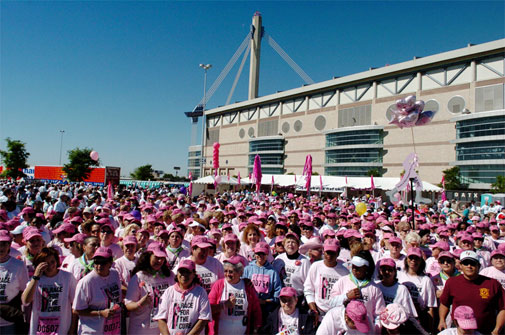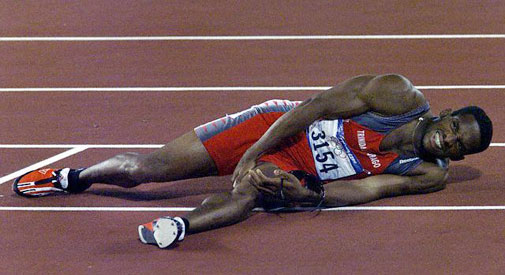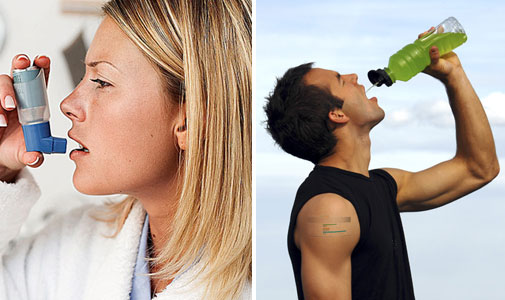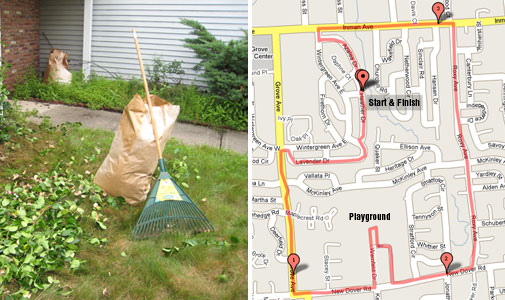posted on August 22nd, 2008 ·

Cancer patients have been told to maintain an active lifestyle even when they are going through chemotherapy, which often makes them fatigue. Simple activities such as walking or doing resistance band exercises have shown to increase cancer patients’ strength and aerobic capacity. Exercising helps patients overcome cancer as well.
If cancer patients can benefit from exercising, why shouldn’t we, the healthy individuals, follow their lead and stay active?
Tags: Exercise
posted on August 22nd, 2008 ·

We have all seen it…sprinters, soccer players, or long distance runners stop running in the middle of the competition and grab their hamstrings while screaming on top of their lungs. Hamstring injury is one of the most popular sports related injuries that proper training and preventive techniques are critical to anyone who participate in any forms of exercise.
According to National Strength and Conditioning Association, doing Nordic Eccentric Hamstring Exercise results greater gains in hamstring strength and stability than tradition hamstring curls. Nordic Eccentric Hamstring Exercise also reduces hamstring injury as the research has found in elite male soccer players.
When implementing Nordic Hamstring Exercise in weekly workout, we should do 3 sets, with 12, 10, and 8 repetitions respectively. Finally, The hamstring exercise is best performed on a soft surface.
Tags: Injury Prevention · Exercise
posted on August 21st, 2008 ·

After running for a total of 20 miles in the past three days, I focused on agility and speed in today’s workout. I warmed up with 2 miles of jogging and spent 40 minutes sprinting.
Workout for Speed and Agility
- 50-yard progressive sprints, from 50% of top speed to full sprint: 6 sets w/ no rest
- 50-yard full sprints: 10 sprints w/ 10-second rest
- 50-yard full sprints w/ backpaddling: 10 sets w/ 10-second rest
- ladders: 25 yards followed by 50 yards: 10 sets w/ 15-second rest
Speed and agility workout helps me regain explosiveness and quickness in changing direction, which I have lost a little from training for long distance running. Our body contains two types of muscles: fast and slow-twitch. Fast-twitch muscles are used during anaerobic exercises, such as sprinting and lifting heavy weight. On the other hand, we use slow-twitch muscles for aerobic (endurance) exercises, such as long distance running or biking.
Although training for endurance gives us many benefits in terms of health, our fast-twitch muscles are compromised during long distance training; our body works under aerobic phase where we rely on slow-twitch muscles. A mix of endurance and anaerobic training will keep our muscles balanced and help us stay mobile.
Tags: Exercise
posted on August 20th, 2008 ·

Stepping onto a scale can be dreadful; we’d all like to fall into the “normal range” on the BMI (body mass index) chart. However, many of us who exercise consistently may find our BMI to be higher than the target range. But are we overweight? Are we still unfit even we exercise at least 30 minutes a day? Not necessarily.
Generally speaking, overweight individuals are unfit and may be at risk of diseases. But “overweight” and “unfit” deserve a clearer distinction. Although “overweight” and “fit” contradict each other, an individual can be overweight but considered fit by being able to exercise in moderate intensity. BMI only measures the weight relative to a person’s height; an active person may fall into the category of “overweight” by having more muscle mass (muscles weight more than fat). Also, according to NY Times’ report, fitness, measured by treadmill test, is a better indicator of a person’s general health. People with bigger frame but could perform better on the treadmill tend to live longer than skinnier and less fit individuals.
I encourage you to asses your health by doing practical fitness testing, such as 1-mile run/walk, push-ups, or crunches. Stepping onto a scale and categorizing yourself on the BMI chart could discourage you or mask the possibility of health problems. Guinea Pig wants you to be fit!
Tags: Exercise
posted on August 20th, 2008 ·

Glycemic Index has been the constant topic when we analyze our carbohydrate consumption. We have been told that consuming carbohydrates with low glycemic index, such as whole grains, would help us control weight and prevent diseases. But what’s the truth behind those numbers assigned to our beloved bread, noodles, or desserts?
There are two hormones, insulin and glucagon, to be concerned with when we discuss glycemic index. Insulin facilitates the entry of glucose to our muscles cells and be used as energy during exercise. However, if too much glucose is released from our livers, insulin would carry the glucose into our fatty cells and be stored as fat. When the secretion of insulin increases, glucagon (secreted by pancreas like insulin), which breaks down fat, decreases. A high glycemic index meal increases the secretion of insulin and increases the fat stored in fatty cells.
After the spike of insulin due to high glycemic index meal, the secretion of the insulin decreases dramatically to below pre-meal level. When insulin is below the pre-meal level, other hormones, such as growth hormone, cortisol, and adrenaline, are released and cause hunger drive; therefore, after consuming a high glycemic meal, we get hungry and snack more often. We eventually gain weight.
Last, besides picking the “good carbs” with low glycemic index, we need to pay attention to glycemic load, which measures our overall carbohydrate consumption (formula: glycemic index * grams of cargohydrates/100). Portion control is as critical as the type of carbohydrates that we consume; too much of “good carbs” will have high glycemic effect due to the large portion.
Final words: pick “good carbs” and eat with moderation.
Tags: Diet
posted on August 19th, 2008 ·

With a proper training program implemented, a pitcher can strength train and pitch effectively during a long baseball season.
There are generally three types of pitchers on a baseball team; starters, relievers, and closers. They all have different responsibilities, which make them differ in their kinetic and kinematic demands of pitching. Great communication among pitching coach, strength coach, and athletic trainer is critical in helping a pitcher improve his or her performance.
For general program development, a pitcher should train hardest when his scheduled outing is furthest away from the training day. In a hard training session, a pitcher will be expected to lift heavy weights, 85~95 % of his maximum strength. As the pitcher’s outing closes in, he should focus on the speed of movement and decrease the weight lifted, to 40~45% of maximum strength, for faster recovery.
Besides strength training, a pitcher needs to develop and maintain his shoulder stability and mobility to minimize the chance of getting injured. To train for stability and mobility, a pitcher can implement prehabilitation program, which involves light weight shoulder exercises and multiplanar shoulder rotations, for everyday.
A pitcher needs a routine to train and pitch effectively. Knowing the demand of a pitcher’s responsibilities can help strength and conditioning professionals design an effective program. Strength training, formerly known as a detriment to a pitcher’s performance, has become a critical part of a pitcher’s career.
Tags: Injury Prevention · Exercise
posted on August 19th, 2008 ·

EIB, exercise-induced brochospasm (exercise-induced asthma), is common to many of us, even to the best athletes in the world. The symptoms are coughing, shortness of breath, chest pain or tightness, and wheezing. Exercise scientists have speculated that EIB results from loss of heat, water, or both from the lungs during exercise.
When EIB occurs to you during exercise, you’d need to reduce the intensity but not stop exercising immediately (the benefit of warm-down and readjust your body back to equilibrium). Also, since losing water could be the main cause of EIB, you’d need to hydrate yourself right away and remove yourself from any environmental allergens or irritants, such as cold or polluted air, that could contribute to the discomfort.
The best way to prevent EIB from occurring is to visit your primary physician and get a prescription for short-acting bronchodilator. Using bronchodilator before exercising will help the airway stay open. In addition, you can engage in a long term control therapy that can decrease the frequency and severity of EIB when it happens.
Tags: Injury Prevention · Exercise
posted on August 18th, 2008 ·

While we were shutting down another productive weekend and getting ready to go back to work on Monday, Emma Snowsill from Australia dominated the Olympic triathlon by finishing the race in 1:58:27; she beat the second place, Vanessa Fernandes of Portugal, by a large margin of 67 seconds.
Standing only 5 foot 3 inches tall, Emma is an incredible athlete who has overcome various obstacles to be the best triathlete of the world. She has finally gotten over the loss of her ex-boyfriend, Luke Harrop, who was killed in a bike accident while training with her. Emma was also left off of Australian team in 2004 Olympic. However, the hardship has only made Emma stronger; she went on to win 2005 World Championship and make the Australian team for 2008 Olympic.
Congratulations, Emma Snowsill!
Tags: Sporting News
posted on August 17th, 2008 ·
My friend has recently discovered “Posterous”, where you can instantly blog any interesting subject. I tried this instant-blogging tool today and posted some pictures on what I have accomplished since I woke up this morning.
Go ahead, guinea pig this tool and start recording your activities.
Tags: Miscellaneous
posted on August 15th, 2008 ·
The bush in front of my house looked incredibly tall and messy. I have been reluctant to trim the bush because I have seen bees flying around and out of it. I took advantage of today’s misty and wet morning to trim the bush and allow the sun light come into the house.

I also ran about 3.7 miles and did body weight training at a playground before working in my yard. Exercising helps me release my adrenaline, which gets me pumped before doing housework.
Body Weight Training:
- Front & side kicks: 2 x 15 each leg
- Pull-ups: 5 x 10 (normal & close grip)
- Push-ups: 3 x 30 (wide, normal, & close grip)
- Front, side, & backward lunges: 1 x 15 steps each leg
- Dips (on a pull-up bar): 2 x 15
Tags: Exercise











